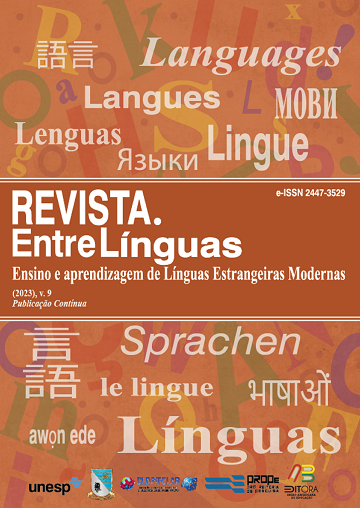Tecnologia educacional e princípios e métodos de ensino de inglês
DOI:
https://doi.org/10.29051/el.v9i00.17747Palavras-chave:
Tecnologia educacional, Melhoria da qualidade, Inglês, Educação tradicionalResumo
Os instrumentos auxiliares de ensino como interface têm conseguido desempenhar bem o seu papel e seria melhor se os professores tivessem as habilidades necessárias para usar essas ferramentas. Hoje, especialistas e pensadores de todo o mundo enfatizam a importância e determinam o papel da tecnologia educacional no processo de aprendizagem e acreditam que o uso ideal de facilitadores de ensino em vez de professores terá um efeito construtivo na melhoria da qualidade da educação. Devido aos problemas do sistema educacional do nosso país no ensino de inglês e à falta de habilidades dos alunos treinados, especialmente em falar, ouvir e escrever, muitos pais tentam cobrir essa deficiência no sistema educacional recorrendo a escolas avançadas. Assim, neste artigo, decidimos examinar o papel do ensino de tecnologias assistivas na facilitação do ensino de língua inglesa em salas de aula.
Downloads
Referências
ATKINS, N. E.; VASU, E. S. Measuring knowledge of technology usage and stages of concern about computing: A study of middle school teachers. Journal of Technology and Teacher Education, v. 8, n. 4, p. 279-302, 2000.
EGBERT, J. L.; PAULUS, T. M.; NAKAMICHI, Y. The impact of CALL instruction on classroom computer use: A foundation for rethinking technology in teacher education. Language Learning & Technology, v. 6, 2002.
FETSCO, T.; MC CLURE, J. Educational psychology. New York: Allyn and Bacon, 2005.
HANSON-SMITH, E. Classroom practice: Using multimedia for input and interaction in CALL environments. In: HANSON-SMITH, E. (Ed.). CALL environments: Research, practice, and critical issues. Alexandria, VA: TESOL, 1999. p. 189-215.
HOFSTETER, F. T. Multimedia literacy. NY: MC Grow – Hill, 1996.
JOHNSON, D.; EISENBERG, M. Learning and Teaching Information Technology Computer Skills in Context. ERIC Digest, 2006.
JONES, J. E. Computer Simulated Experiments in High School Physics and chemistry. 1972. 127 f. Dissertation (Doctorate) – Iowa State University, 1972.
KIM, H. Teachers as a barrier to technology-integrated language teaching. English Teaching, v. 57, n. 2, p. 35-64, 2002.
KULIK, J. A.; BANGART, R. L.; WILLIAMS, G. W. Effects of Computer Based Learning on Secondary School Students. Journal of Educational Psychology, v. 75, p. 12-26, 1983.
LABORDA, J. G.; ROYO, T. M. Educational Technology & Society, v. 10, n. 3, p. 320-324, 2007.
LAM, Y. Technophiliacs, technophobia: A preliminary look at why secondlanguage teachers do or do not use technology in their classrooms. Canadian Modem Language Review, v. 56, n. 3, p. 389-420, 2000.
MORGIL, I. et al. Traditional and computer – assisted learning in teaching acid and bases. Chemical Education Research and Practice (CERP), v. 6, n. 2, p. 52- 63, 2005.
ORTIZ, A. English language learning with special needs; Effective instructional strategies. Journal of Learning Disabilities, v. 30, p. 420-321, 2007.
PARK, C.; SON, J.-B. Implementing Computer-Assisted Language Learning in the EFL Classroom: Teachers’ Perceptions and Perspectives. International Journal of Pedagogies and Learning, v. 5, n. 2, p. 80-101, 2009.
REAMON, D. T.; SHEPPARD, S. D. The role of simulation software in an ideal learning environment. In: DESIGN ENGINEERING TECHNICAL CONFERENCES, 1997, Sacramento. Proceedings […]. Sacramento, CA, 1997.
SCHACTER, J. The Impact of Educational Technology on Student Achievement: What the Most Current Research Has to Say. ERIC Digest, 1999.
SHIN, H.-J.; SON, J.-B. EFL teachers' perceptions and perspectives on Internetassisted language teaching. CALL-EJ Online, v. 8, n. 2, p. 14-31, 2007.
SWAIN, N. K.; ANDERSON, J. A.; KORRAPATI, R. B. Role of simulation software in enhancing student learning in computer organization and microcontroller courses. In: INTERNATIONAL CONFERENCE, 2008, Nashville. Proceedings […]. Nashville, TN, USA, 2008. Available: http://www.ijme. us/cd_08/PDF/135%20ENT%20207.pdf. Access: 10 Jan. 2022.
WENGLINSKY, H. The Relationship Between Educational Technology and Student Achievement in Mathematics: Educational Testing Service Policy Information CenterSteed. Marlo & Marzek, Rick 1999.
WOOLFOLK, A. E. Educational psychology. Boston: Allyn Bacon, 2001.
Downloads
Publicado
Como Citar
Edição
Seção
Licença

Este trabalho está licenciado sob uma licença Creative Commons Attribution-NonCommercial-ShareAlike 4.0 International License.
Os manuscritos aceitos e publicados são de propriedade da Revista EntreLínguas. Os artigos publicados e as referências citadas na Revista EntreLínguas são de inteira responsabilidade de seus autores.
Transferência de direitos autorais – autorização para publicação
Caso o artigo submetido seja aprovado para publicação, já fica acordado que o(s) autor(es) autoriza(m) a UNESP a reproduzi-lo e publicá-lo na EntreLínguas, entendendo-se os termos “reprodução” e “publicação” conforme definição respectivamente dos incisos VI e I do artigo 5° da Lei 9610/98. O artigo poderá ser acessado pela rede mundial de computadores (Internet), sendo permitidas, a título gratuito, a consulta e a reprodução de exemplar do artigo para uso próprio de quem a consulta, desde que haja a citação ao texto consultado. Essa autorização de publicação 328 EntreLínguas, Araraquara, v. 1, n .2, p. 323-328, jul./dez. 2015 não tem limitação de tempo, ficando a UNESP responsável pela manutenção da identificação do(s) autor(es) do artigo. Os artigos publicados e as referências citadas na Revista EntreLínguas são de inteira responsabilidade de seus autores.











